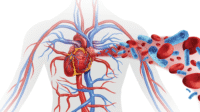Bone metastases are secondary cancers that arise when cancer cells spread to the bone from another part of the body. Unlike osteosarcomas, they’re not primary bone cancers.
A diagnosis of bone metastasis can be devastating, signifying that the patient’s cancer has advanced and become incurable. What’s more, bone metastasis may cause significant pain and decrease the quality of life. As a nurse, you can play a key important role in identifying bone metastases early and supporting the patient throughout diagnosis and treatment.
Pathophysiology
Normally, bone tissue is renewed and replaced through the remodeling process. In normal, healthy adults, a homeostatic balance exists between resorption of old bone cells by osteoclasts and replacement with new bone cells by osteoblasts. This process maintains strong, healthy bones.
But when the process breaks down, an osteolytic or osteoblastic bone lesion develops. (See How bone metastasis develops by clicking on the PDF icon above.)
Some patients, such as those with breast cancer, may have a combination of osteolytic and osteoblastic lesions. Both types can trigger a vicious cycle of bone destruction and tumor growth, weakening the bone and raising the risk of fractures, spinal-cord compression, and pain. Early identification and treatment of bone metastases are crucial in slowing this cycle and controlling tumor growth and skeletal destruction.
Incidence
The skeleton is the third most common site of cancer spread, after the liver and lung. Breast and prostate cancer account for approximately 80% of bone metastases. Nearly all multiple myeloma patients have some degree of bone involvement and destruction. In undiagnosed multiple myeloma, bone pain and fracture commonly are the presenting signs and symptoms. Patients with thyroid, lung, or kidney cancer as well as melanoma also are at risk for bone metastasis. (See Bone metastases incidence by tumor type by clicking on the PDF icon above.)
Bone metastases are most common in the spine (the vertebrae, specifically), followed by the pelvis. The ribs, upper extremities, sternum, and lower extremities also are at risk.
Complications
Bone metastases may cause serious and even life-threatening complications, including fractures, spinal-cord compression, and hypercalcemia. These conditions may arise as complications of known bone metastases or may be the first indications of metastases.
Pathologic fractures
Roughly half of bone metastases lead to pathologic fractures. Fractures are most common in the long bones and in patients with multiple myeloma. They heal extremely slowly; many don’t heal at all, causing significant pain and decreased functional abilities. Usually, these fractures are associated with sudden onset of sharp, severe pain. The patient may need to undergo surgery, with metal rods, plates, screws, nails, or pins inserted to strengthen or provide structural support to the damaged bone.
Spinal-cord compression
Unless diagnosed and treated early, spinal-cord compression can lead to paralysis, incontinence, and other neurologic problems. Back pain, which may be excruciating, is the hallmark of spinal-cord compression. Patients also may complain of motor weakness, sensory loss, and bowel and bladder dysfunction. Spinal-cord compression most frequently is linked to bone metastases secondary to breast, lung, and prostate cancers. Impending spinal-cord compression is an oncologic emergency necessitating immediate radiation therapy and corticosteroids.
Hypercalcemia
Hypercalcemia (serum calcium level above 10.5 mg/dL) is the most common metabolic complication of bone metastasis. Most patients lack symptoms initially. If hypercalcemia progresses, they may experience lethargy, anorexia, nausea, and constipation. Severe hypercalcemia may impair mental status. Hypercalcemia is most frequent in bone metastases secondary to lung, breast, and kidney carcinomas and multiple myeloma.
Signs and symptoms
Bone pain is the primary presenting symptom of bone metastases. Typically, the pain is dull and aching, unrelieved by inactivity or rest, and of slow onset; patients may be unable to identify when it began.
Although its intensity may vary, the pain is persistent. Patients commonly describe it as deep and generalized, and may report tingling and numbness or an “achy, funny feeling in my bones.” Some may make light of it, attributing it to arthritis or “old age,” particularly if their primary cancer has been stable or in remission for some time. Healthcare professionals need to recognize these complaints as potential symptoms of bone metastases, particularly in high-risk patients. Besides obtaining a careful history, be sure to ask pertinent assessment questions to help detect bone metastases and alert other healthcare providers. (See Assessing patients for bone pain by clicking on the PDF icon above.)
Diagnosis
A patient with a history of cancer and suspicious bone pain should undergo diagnostic tests to detect metastases. Plain X-rays typically are the first imaging test ordered; relatively inexpensive, they’re accurate in diagnosing osteolytic bone lesions. However, X-rays are localized and lack sensitivity; also, they rarely detect bone lesions until these are at least 1 cm and cause loss of 30% or more of the bone matrix.
A single bone scan, on the other hand, can detect bone lesions as small as 2 mm anywhere in the skeleton. But this test isn’t specific; the radioactive element lights up any bone areas where increased metabolic activity exists. The highlighted areas may be related to old trauma, infection, or arthritis rather than bone metastasis.
Computed tomography, magnetic resonance imaging (MRI), and position emission tomography can detect metastatic bone lesions with considerable sensitivity—but at a greater expense. They’re commonly done only when X-rays and bone scans are inconclusive. MRI is used if a spinal-cord lesion is suspected or to distinguish fractures secondary to osteoporosis from those caused by bone metastases.
Treatment
Treatment focuses on relieving pain, controlling tumor growth, and preserving the patient’s function and mobility. Pain can be managed with analgesics, particularly nonsteroidal anti-inflammatory drugs and opioids.
In most patients, external-beam radiation therapy provides excellent palliation and disease control for localized bone metastases. It may be achieved with relatively few daily treatments. Strontium-89, an injectable radiopharmaceutical, has been effective for widespread metastatic bone disease. Be sure to inform patients scheduled for this treatment that a pain “flare” may occur initially and that achieving pain relief may take 2 to 3 weeks.
In addition, systemic cancer therapies, including chemotherapy and hormonal therapies, may be used to treat the primary cancer and may slow the metastases rate. Some patients require surgical stabilization to prevent or treat pathologic fractures and reduce pain.
Bisphosphonates
I.V. bisphosphonates bind readily to the bone matrix and inhibit osteoclast-mediated bone resorption, slowing the bone remodeling cycle and increasing bone mineral density. These drugs reduce and delay the development of pathologic fractures, spinal-cord compression, and hypercalcemia—as well as the pain caused by these conditions.
The only bisphosphonates approved for metastatic bone disease are zoledronic acid (Zometa) and pamidronate injection (Aredia). Given I.V. approximately every 4 weeks, these drugs are linked to renal insufficiency, particularly in patients who aren’t well hydrated. Advise patients to have serum creatinine levels measured before each treatment and to drink plenty of fluids. Inform them they may experience a flulike syndrome with mild fever, particularly after the first dose; reassure them this syndrome generally is self-limiting and responds well to acetaminophen.
Other drugs
Some practitioners also prescribe oral calcium to help support bone and vitamin D supplements to aid the body’s calcium absorption and utilization.
Nursing care
Your role includes helping to detect bone metastases in cancer patients. Nurses who conduct pain assessments may be the first healthcare team members to identify the pain of bone metastases and to alert colleagues to the need for diagnostic testing.
Teach patients and their families about the disease, diagnosis, and treatment to help optimize outcomes. Giving them the information they need empowers them to become their own best advocates and improves their treatment adherence. (See Patient education resources by clicking on the PDF icon above.)
Provide emotional support as well. Patients and their families need help to cope with the disease and its implications.
Selected references
Albert K. Evaluating bone metastases. Clin J Oncol Nurs. 2007;11(2):193-197.
Coleman RE. Clinical features of metastatic bone disease and risk of skeletal morbidity. Clin Cancer Res. 2006:12(suppl 20):6243S-6249S.
Fitch MI, Maxwell C. Bisphosphonate therapy for metastatic bone disease: the pivotal role of nurses in patient education. Oncol Nurs Forum. 2008;35(4):709-713.
Gralow JR, Biermann JS, Farooki A, et al. NCCN Task Force Report: bone health in cancer care. J Natl Compr Canc Netw. 2009;7(suppl 3):S1-S32.
Khan MN, Khan AA. Cancer treatment–related bone loss: a review and synthesis of the literature. Curr Oncol. 2008;15(suppl):S30-S40.
Lipton A. Pathophysiology of bone metastases: how this knowledge may lead to therapeutic intervention. J Support Oncol. 2004;2(3):205-213.
Reich CD. Advances in the treatment of bone metastases. Clin J Oncol Nurs. 2003;7(6):641-646.
Nancy Thompson is an oncology Clinical Nurse Specialist at the Swedish Cancer Institute in Seattle, Washington.


















